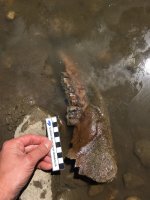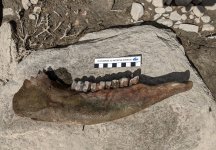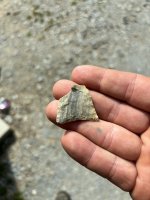Bison bison or Bos Taurus (cow)? Found on a river gravel bar in Sothern Minnesota. Sediments in the area range from cretaceous to holocoen with a good amount of Wisconsin lobe glacial till. Previously we have found other bison (long bones and teeth), elk, bear, mammoth, and ancient horse...
You are using an out of date browser. It may not display this or other websites correctly.
You should upgrade or use an alternative browser.
You should upgrade or use an alternative browser.
Sandmaniac
Full Member
- Jan 23, 2007
- 133
- 57
- Detector(s) used
- Minelab Safari
- Primary Interest:
- All Treasure Hunting
I'd have to yes.


Upvote
0
SweepNbeep
Full Member
- Mar 3, 2017
- 190
- 294
- Detector(s) used
- Garrett AT Pro & Ace 400
- Primary Interest:
- Other
Good question. We find jaws like that in North Dakota, which was home to millions of both cows and bison over the years. I’ve looked the up somewhat, but don’t know how to tell 100%. Anybody know how to? My guess would be by the teeth.
Upvote
0
SweepNbeep
Full Member
- Mar 3, 2017
- 190
- 294
- Detector(s) used
- Garrett AT Pro & Ace 400
- Primary Interest:
- Other
Yours looks like bison teeth, Id say. But the jaws all look the same to me.
Upvote
0
Older The Better
Silver Member
- Apr 24, 2017
- 3,135
- 5,814
- Detector(s) used
- Whites Eagle Spectrum
- Primary Interest:
- All Treasure Hunting
The teeth are key to telling between bison and cow I believe the stylid on bison teeth is detached while on a cow it’s attached with the rest of the tooth
Upvote
0
Red-Coat
Gold Member
The teeth are key to telling between bison and cow I believe the stylid on bison teeth is detached while on a cow it’s attached with the rest of the tooth
Yes, the degree of isolation of the stylid on the molars is a pretty reliable indicator, although not 100% conclusive. I posted a diagnostic picture of a bison molar with an isolated stylid a while ago:
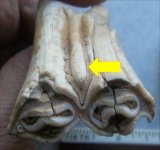
http://www.treasurenet.com/forums/what/623248-cow-bison.html
In addition to that picture, when the molars have significant occlusal wear, the isolated stylid may appear as a ring donut or oval/teardrop shape that's distinctly separate from the main cusps of the tooth. Like this:
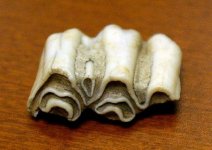
Upvote
0
GoldieLocks
Bronze Member
I was just saying g how a TV show was explained ing that it wasn't just the Spanish that introduced the horse to the US area. An older smaller version had been found.
Upvote
0
Older The Better
Silver Member
- Apr 24, 2017
- 3,135
- 5,814
- Detector(s) used
- Whites Eagle Spectrum
- Primary Interest:
- All Treasure Hunting
Had camels and cheetahs too
Upvote
0
Back-of-the-boat
Gold Member
- Apr 18, 2013
- 6,882
- 8,498
- Detector(s) used
- AT GOLD/Garrett /C.Scope cs4PI/Garrett(carrot) pro pointer/ 5x8 double d coil and sniper coil/Lesche digger/Lesche "T" handle shovel.
- Primary Interest:
- All Treasure Hunting
It looks more like a horses jawbone, the way the front of the jawbone is straight out and not curved up.
Upvote
0
Red-Coat
Gold Member
How does a red coat know so much about American bison?
We had bison in Europe too of course, although they would be a rare find in Britain, unless from the North Sea between us and continental Europe. Nevertheless, I have a large fossil and bone collection from all around the world.
I was just saying g how a TV show was explained ing that it wasn't just the Spanish that introduced the horse to the US area. An older smaller version had been found.
Horses originally evolved in North America (the wild horse Equus ferus and several species of stilt-legged horse - notably Equus francisci and Equus calobatus) and migrated across the Bering land bridge into Eurasia. They seem to have undergone several extinctions in North America and re-populated back from Eurasia. They were finally hunted (maybe) to extinction in North America at the end of the last ice age, around 10,000-12,000 years ago.
At the beginning of what is known as the “Columbian Exchange” when all kinds of new species of animals and plants were introduced to the Americas, there were no horses of any kind on the American continent. Horses (domesticated ones) were reintroduced to the mainland by the conquistadore Cortés in 1519 via the Yucatan Peninsula in Mexico and a little later by De Coronado via New Mexico and De Soto via Florida around 1539-1540.
It looks more like a horses jawbone, the way the front of the jawbone is straight out and not curved up.
When jawbone diagnostics are uncertain or compromised by deterioration, again it’s the molars that provide the best identification for Bovid vs Equid.
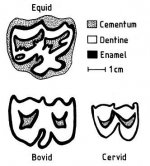
Upvote
0
sergeir
Greenie
- Thread starter
- #13
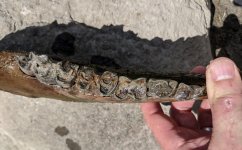
Thank you all for the responses, images, and additional information! Yes - from past experience teeth and stylids are the key as many have mentioned. If the stylids are isolated there's a better chance it's bison bison. But I've read information provided by a few Paleontologists that more study, morphometrics, needs to be done. I.e. "sometimes" Bos Taurus (domestic cattle) will have isolated stylids also and the amount of wear may also be a factor into whether the stylid appears isolated or not in both species. However, all is not lost for my specimen - I have also read that if the M3 molar is over 40mm in length this also may indicate bison bison. In this case, the M3 is 42 cm across the chewing surface the stylids do not appear completely isolated, however. They are worn very low - I added an additional photo above. I have donated this specimen to the Science Museum of Minnesota so hopefully, I get a definitive ID at some point. Either way, it was the first bovine jaw I found. It was big, very crusty, one of my favorite finds of 2020. If I ever find out 1000% I will update this thread or post about it in the Minnesota Fossil Finders group.
Last edited:
Upvote
0
Top Member Reactions
-
 2602
2602 -
 1152
1152 -
 1044
1044 -
 892
892 -
 871
871 -
 845
845 -
 786
786 -
 675
675 -
 659
659 -
 640
640 -
 493
493 -
 472
472 -
 467
467 -
 463
463 -
 459
459 -
 431
431 -
 415
415 -
 408
408 -
O
401
-
 389
389
Users who are viewing this thread
Total: 2 (members: 0, guests: 2)


